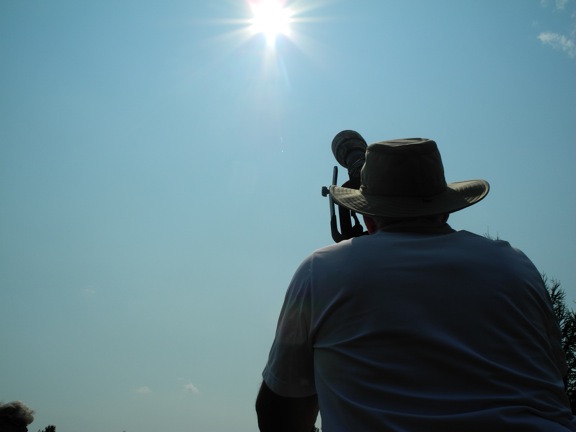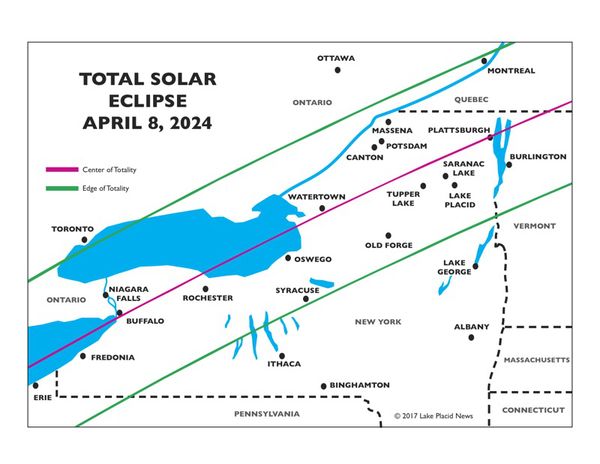Residents, visitors bond at local solar eclipse event

A man photographs the Aug. 21, 2017 eclipse through a camera with a solar filter and a very powerful zoom lens at the Wild Center in Tupper Lake. (News photo — Aaron Cerbone)
TUPPER LAKE – Excitement abounded Monday afternoon, Aug. 21, as astronomers, eclipse enthusiasts and solar tourists descended upon this town to watch the solar eclipse that captivated people nationwide.
Viewing stations at the Wild Center and Adirondack Public Observatory were packed full of visitors with their eyes on the sky to see the moon cover 63 percent of the sun.
More than 500 people gathered at the at APO’s Roll-Off-Roof Observatory on Big Wolf Road to find elusive solar glasses – which were otherwise sold out in the area – to chat with astronomers and to line up by dozens to catch a peek through a solar telescope.
“I call this the Woodstock of the eclipse,” astronomy enthusiast Joe Van Putten said.
Glasses ran out at libraries, museums and other vendors as they were in high demand. Observatory directors were thrilled by the large turnout and eagerness of kids to learn about what goes on outside Earth.

This map shows the path of the next total solar eclipse to impact the United States, which will be on April 8, 2024. Totality touches Mexico first before spreading from Texas to Maine and to Canada. The magenta line shows the center of totality, which is bound by the green lines. Much of the Adirondack Park, including Lake Placid, will witness a 100 percent eclipse. (News artwork — Andy Flynn)
“The expressions that they have and some of the questions they come up with are just phenomenal,” said APO co-founder Marc Staves of Tupper Lake.
“When I’m looking at the community, it’s nice to see all the youth that are enthusiastic to look through the solar glasses, look at the pictures and ask me questions about the sun,” said Tim Connolly, of Saranac, a solar hobbyist.
Retired teacher Beryl Szwed of Saranac Lake saw the eclipse at the observatory with her grandchildren Braydon, 8, and Kayla, 5. They had never been there before and were drawn for a special day of checking in on the eclipse progress, making mud pies and learning about the science behind an eclipse.
Directors believe the event was a boon for awareness of the observatory and awakening an interest in astronomy for attendees who came from near and far. They say this is a good sign as the observatory slowly makes progress on its Astro-Science Center, a multi-million-dollar museum for researchers and public observers alike.
Staves, a director at the observatory, has been an amateur astronomer since he was 13 years old and remembers a similar partial eclipse in Tupper Lake during the 1990s, when there was much less excitement, technology and knowledge around the phenomenon.
“None of this was available back then,” Staves said.
“To see what we’ve accomplished here in the matter of 10 years is mind-boggling,” said Gib Brown, a director at the observatory and a meteorologist at WPTZ-TV.
Brown recorded temperatures at the observatory site during the eclipse. The sweltering heat dropped from 87 degrees Fahrenheit at 1:30 p.m. to 79.5 degrees at 2:45 p.m., then rose as the moon revealed the full sun once again.
At the Wild Center, viewing stations on the Wild Walk and the shore of Greenleaf Pond drew crowds of 1,800 guests, intrigued by the solar telescopes, cameras and binoculars in use. An average attendance for the Wild Center on a summer day is currently around 1,300. Researchers, amateur astronomers and guests all had access to the equipment, taking turns gazing at the obscured sun while hearing about the science behind the event.
Inside, a multi-state discussion was held at the Flammer Theater, featuring NASA scientists answering questions by video from audiences in Mississippi, Ohio, North Carolina and California as well as New York. A Wild Center guest named Natalie asked how far the moon moves away from Earth annually and how scientists know that. The moderators said the moon moves away a couple of inches each year, to the point where eventually there will be no more total solar eclipses. When Apollo astronauts visited the moon, they left reflectors that can be hit with powerful lasers to track distance by measuring the time it takes for light to return.
Directors at the Wild Center said they hope the eclipse teaches people to take a deeper look at something that is always around us, because some observations about the sun can be made every day.
“I think any time you talk about things in the cosmos, you can feel very small and insignificant,” said Simon Schreier, a coordinator at the nature museum, “or you can recognize how special it is that you are here on this planet, and you can observe these things and understand them.”
At the same time, the strange phenomena of the eclipse took center stage.
“There’s a lot of anecdotal evidence about what animals do during eclipses, how it impacts their behaviors,” Schreier said. “For the first time, NASA is asking for citizens scientists to collect data on what animals do during an eclipse.”
One creature native to the Adirondacks are the many kinds of orb weaver spiders, which repair and construct their webs at night. Citizen scientists were asked to observe orb weaver spiders, as anecdotes say they destroy and reconstruct their webs during an eclipse.
Connolly, a solar photography hobbyist, came to the observatory prepared. Hauling three telescopic solar cameras, posterboard and computer equipment into a tent, he set up a complicated system for capturing the eclipse. This state police investigator and his father, who shares the same name, photograph the sun nearly every morning using equipment he acquired from Van Putten, a close friend he met at an astro-imaging course. Watching from the tent with Van Putten, Connolly shot 500 picture bursts at 13 frames per second to not miss any major sights during the event.
Both the Wild Center and the APO considered this eclipse to be a dry run for one coming up on April 8, 2024, when Tupper Lake, Saranac Lake and Lake Placid will be directly in the path of totality.
- This map shows the path of the next total solar eclipse to impact the United States, which will be on April 8, 2024. Totality touches Mexico first before spreading from Texas to Maine and to Canada. The magenta line shows the center of totality, which is bound by the green lines. Much of the Adirondack Park, including Lake Placid, will witness a 100 percent eclipse. (News artwork — Andy Flynn)




